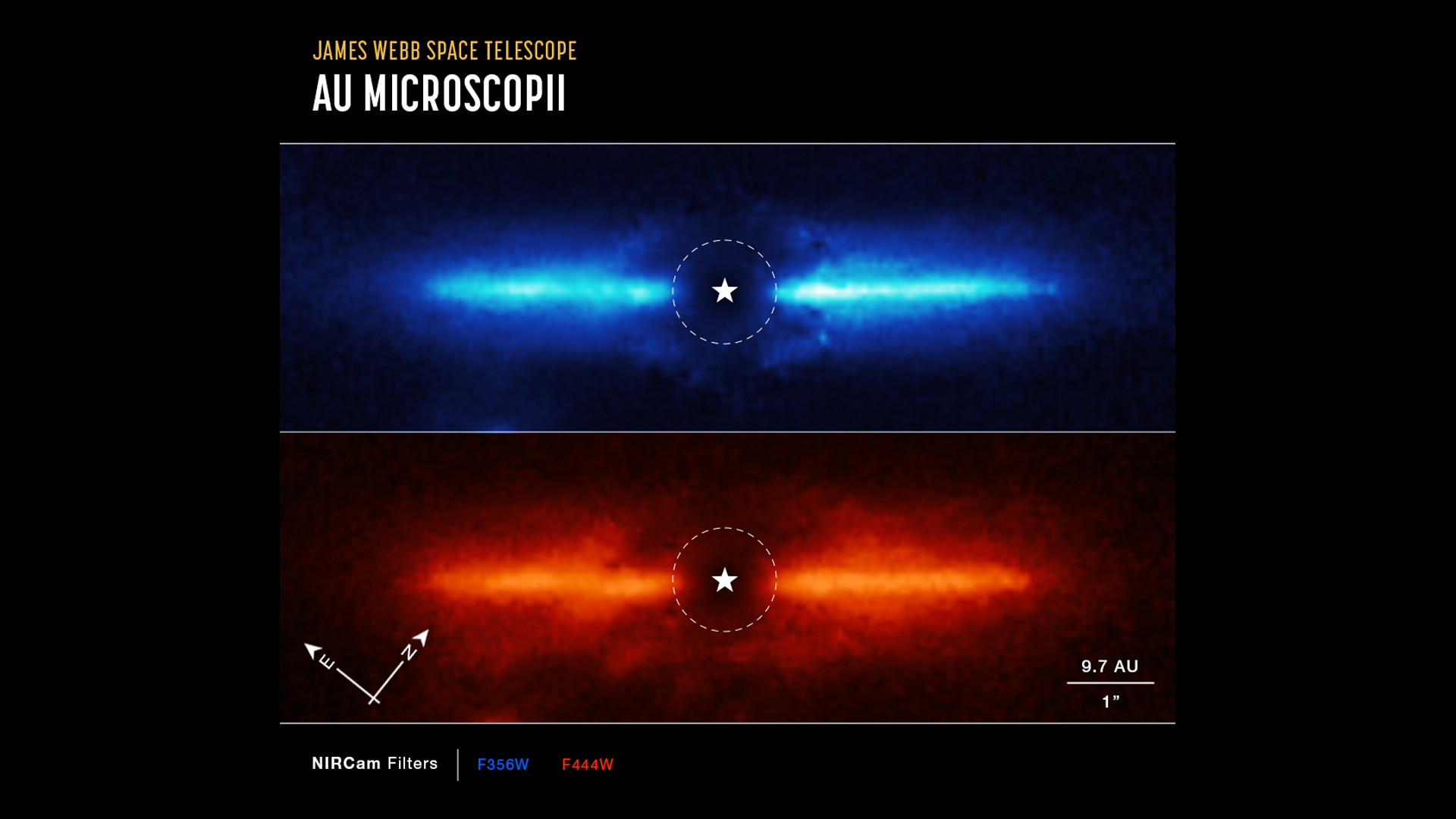James Webb Space Telescope's ground-breaking study of a planet-forming disk hints at future exoplanet discoveries

The James Webb Space Telescope has for the first time peered inside a planet-forming disk of dust surrounding a nearby star, a development promising to supercharge the search for exoplanets.
Using the James Webb Space Telescope's near-infrared camera (NIRCam), a team of astronomers led by Kellen Lawson, a postdoctoral program fellow at NASA Goddard Space Flight Center, observed the surroundings of a red dwarf star known as AU Microscopii or AU Mic.
Red dwarfs are rather unassuming stars that make up the largest population of stars in our galaxy, the Milky Way. Most of the time, red dwarf stars are too faint to see in the visible light, which is why observing them in the heat-carrying infrared wavelengths, those that Webb specializes in, is useful. Astronomers have known that AU Mic is surrounded by a planet-forming disk of gas and dust and have previously discovered two exoplanets orbiting the star thanks to the star's periodic dimming caused by the planets' crossing in front of the star, which was detected by NASA's exoplanet hunter TESS.
Related: James Webb Space Telescope's 1st year in space has blown astronomers away
Various teams have made attempts to peer inside the disk using Earth-based telescopes as well as Webb's predecessor, the Hubble Space Telescope. These telescopes, however, mostly detecting visible light, couldn't match Webb's dust penetrating abilities.
"Our first look at the data far exceeded expectations," Josh Schlieder, the study's co-author, said in a statement. "It was more detailed than we expected. It was brighter than we expected. We detected the disk closer in than we expected. We're hoping that as we dig deeper, there's going to be some more surprises that we hadn't predicted."
Infrared light has longer wavelengths than visible light and is less scattered by dust, providing a window into these otherwise obscured regions of the universe. The team was able to study the disk thanks to a coronagraph mounted on NIRCam, which can block the star's light, allowing the astronomers to search for very faint objects as close as 5 astronomical units from the star (1 astronomical unit equals the distance between the sun and Earth which is 460 million miles or 740 million km).
Get the Space.com Newsletter
Breaking space news, the latest updates on rocket launches, skywatching events and more!
"This is the first time that we really have sensitivity to directly observe planets with wide orbits that are significantly lower in mass than Jupiter and Saturn," Lawson said the statement. "This really is new, uncharted territory in terms of direct imaging around low-mass stars."
Exoplanets are extremely difficult to observe directly because they are so much fainter than the stars they orbit. Webb made headlines in September when it directly imaged its first exoplanet, one orbiting a star called HIP 65426 located some 385 light-years from Earth. That exoplanet, however, lives very far from its parent star (much farther than the solar system's outermost planet Neptune lives from the sun), and is also extremely massive, about 12 times the size of the solar system's largest planet Jupiter.
The latest observations of AU Mic's debris disk promise that even much smaller planets could have their picture taken by Webb in the future.
So far, Webb didn't manage to take a direct image of an exoplanet orbiting AU Mic, but past research uncovered "numerous fast moving clumps" in the debris disk that may have been produced by a yet unknown object, Lawson said in a news conference.
While analysis of the disk is still ongoing, Lawson told reporters that the disk has a definitive blue color. This finding is consistent with previous studies and indicates that the disk is made of small dust grains, causing it to be brighter at shorter wavelengths.
Webb, which can detect infrared wavelengths from 0.6 to 5 microns, clicked these images at 3.56 and 4.44 microns. This marks "the first time the disk has been detected at these wavelengths," Lawson told reporters at the press conference.
AU Mic is cosmologically nearby at less than 32 light-years and relatively young at roughly 23 million years old. It is also one of the rare systems whose debris disk or "birth ring" — a remnant of planet formation still actively replenished by ongoing collisions of small bodies — is nearly edge-on when seen from Earth.
This provides astronomers a hot seat to search for planets, given that most have tilted orbits and would come into view at some point in their revolutions around AU Mic.
Lawson said Webb's capabilities and the study's goal to focus on faint red dwarfs "provided access not just to new types of exoplanets but to exoplanets much more like the outer planets of our own solar system."
The observations of AU Mic were part of a wider campaign focusing on nine nearby red dwarf stars. The team shared the results on Wednesday (Jan. 11) at the annual conference of the American Astronomical Society.
Follow Sharmila Kuthunur on Twitter @Sharmilakg. Follow us on Twitter @Spacedotcom and on Facebook.
Join our Space Forums to keep talking space on the latest missions, night sky and more! And if you have a news tip, correction or comment, let us know at: community@space.com.

Sharmila Kuthunur is a Seattle-based science journalist focusing on astronomy and space exploration. Her work has also appeared in Scientific American, Astronomy and Live Science, among other publications. She has earned a master's degree in journalism from Northeastern University in Boston. Follow her on BlueSky @skuthunur.bsky.social
-
rod "So far, Webb didn't manage to take a direct image of an exoplanet orbiting AU Mic, but past research(opens in new tab) uncovered "numerous fast moving clumps" in the debris disk that may have been produced by a yet unknown object, Lawson said in a news conference. While analysis of the disk is still ongoing, Lawson told reporters that the disk has a definitive blue color. This finding is consistent with previous studies and indicates that the disk is made of small dust grains, causing it to be brighter at shorter wavelengths."Reply
AU Mic has been under study for some time now. Here are some past reports I read on the system.
Probing the innermost region of the AU~Microscopii debris disc, https://arxiv.org/abs/2207.04116
NFANT “HOT NEPTUNE” PROVIDES CLUES TO ITS BIRTH, https://skyandtelescope.org/astronomy-news/infant-hot-neptune-provides-clues-to-its-birth/
My observation. Some older reports indicate the dust mass in the debris disk around AU Mic star is about 10E-2 earth masses or 0.01 earth mass, very small here. The AU Microscopii Debris Disk: Multiwavelength Imaging and Modeling, https://ui.adsabs.harvard.edu/abs/2007ApJ...670..536F/abstract, November 2007. ArXiv, https://arxiv.org/pdf/0705.4196.pdf, 56 pages. "The masses in the inner and outer regions of the porous grain model are around 1.0 \00d7 10^−2 M⊕ and 2.3 \00d7 10^−4 M⊕, respectively."
Two exoplanets are reported at AU Mic. AU Mic b and c. Reported with nearly 12 and some 22 earth masses.
http://exoplanet.eu/catalog/au_mic_b/http://exoplanet.eu/catalog/au_mic_c/
https://exoplanetarchive.ipac.caltech.edu/overview/AU%20Mic%20b#planet_AU-Mic-b_collapsible
https://exoplanetarchive.ipac.caltech.edu/overview/AU%20Mic%20c#planet_AU-Mic-c_collapsible -
motie Replyrod said:"So far, Webb didn't manage to take a direct image of an exoplanet orbiting AU Mic, but past research(opens in new tab) uncovered "numerous fast moving clumps" in the debris disk that may have been produced by a yet unknown object, Lawson said in a news conference. While analysis of the disk is still ongoing, Lawson told reporters that the disk has a definitive blue color. This finding is consistent with previous studies and indicates that the disk is made of small dust grains, causing it to be brighter at shorter wavelengths."
AU Mic has been under study for some time now. Here are some past reports I read on the system.
Probing the innermost region of the AU~Microscopii debris disc, https://arxiv.org/abs/2207.04116
NFANT “HOT NEPTUNE” PROVIDES CLUES TO ITS BIRTH, https://skyandtelescope.org/astronomy-news/infant-hot-neptune-provides-clues-to-its-birth/
My observation. Some older reports indicate the dust mass in the debris disk around AU Mic star is about 10E-2 earth masses or 0.01 earth mass, very small here. The AU Microscopii Debris Disk: Multiwavelength Imaging and Modeling, https://ui.adsabs.harvard.edu/abs/2007ApJ...670..536F/abstract, November 2007. ArXiv, https://arxiv.org/pdf/0705.4196.pdf, 56 pages. "The masses in the inner and outer regions of the porous grain model are around 1.0 \00d7 10^−2 M⊕ and 2.3 \00d7 10^−4 M⊕, respectively."
Two exoplanets are reported at AU Mic. AU Mic b and c. Reported with nearly 12 and some 22 earth masses.
http://exoplanet.eu/catalog/au_mic_b/http://exoplanet.eu/catalog/au_mic_c/
https://exoplanetarchive.ipac.caltech.edu/overview/AU%20Mic%20b#planet_AU-Mic-b_collapsible
https://exoplanetarchive.ipac.caltech.edu/overview/AU%20Mic%20c#planet_AU-Mic-c_collapsible
10E-2 = 10 x 10^-2 = 0.1. -
motie How did they sense the blue color of the disk? With Hubble? I don't think JWST can see blue.Reply -
rod Reply
Correct, I should write 1E-2 which is MS Excel notation :) It is still 0.01 earth mass or less as the report quote shows. "The masses in the inner and outer regions of the porous grain model are around 1.0 \00d7 10^−2 M⊕ and 2.3 \00d7 10^−4 M⊕, respectively."motie said:10E-2 = 10 x 10^-2 = 0.1.
The size of AU mic disc is a variable from what I read in various sources. https://webdisks.jpl.nasa.gov/index.php, it could be 291 au diameter. Applying the MMSN to a 0.5 solar mass star, ~ 1665 earth masses total dust and gas could originally be in the postulated protoplanetary disc with dust mass ~ 17 earth masses.
Reports like this demonstrate how difficult it can be to determine debris discs around *young*, terrestrial size exoplanets documented.
Takeout and Delivery: Erasing the Dusty Signature of Late-stage Terrestrial Planet Formation, https://arxiv.org/abs/2301.05719
Ref - Takeout and Delivery: Erasing the Dusty Signature of Late-stage Terrestrial Planet Formation, 13-Jan-2023, 20-page PDF, attached.
